
ASSOCIATED PRESS
Fred Beebe, hidden in the front hatch driving, and Floyd Newell, top, from General Motors/General Dynamics, demonstrate the new Stryker combat vehicle at Fort Benning, Ga.
Shinseki gives
Stryker thumbs upThe 60 mph armored vehicle
will give the Army more mobility
FORT POLK, La. >> Instead of kicking its tires, Gen. Eric Shinseki evaluated the Army's new armored vehicle by interrogating the soldiers who had driven it, repaired it and maneuvered it through miles of pine forest in west-central Louisiana.
His verdict: "It's ready."
The Army and the rest of the U.S. military are changing profoundly, and the eight-wheeled Stryker -- surprisingly quiet as it streaks down a dirt path at 60 mph -- is leading the way.
Shinseki, a Kauai native and the Army chief of staff, spent a recent day at Fort Polk to get a firsthand look at the Stryker and the new organization built around it, the Stryker Brigade Combat Team. Both are to be declared ready by late summer for combat missions anywhere.
It was Shinseki's final visit with soldiers in the field before retiring as Army chief Wednesday.
He is ending a 38-year career that included service in Vietnam, where he lost part of a foot, and as commander of U.S. peacekeeping forces in Bosnia. The White House has not nominated his successor.
The Stryker symbolizes a historic step toward the goal Shinseki announced in October 1999. He wanted to remake the Army by 2010 into a more versatile force that can move quickly onto distant battlefields, armed with unparalleled ability to dictate the pace of fighting.
"The Stryker is going to be one of the enduring legacies of Shinseki's leadership," said Dan Goure, a defense analyst with the Lexington Institute in Arlington, Va.
Shinseki said there will eventually be six Stryker brigades with about 3,500 soldiers each, including two at Fort Lewis, near Tacoma, Wash., one in Alaska, one in Hawaii and one to be made part of the Pennsylvania National Guard.
The units are capable of arriving at a hot spot within days, far more quickly than a traditional armored unit built around the unmatched firepower of the tank, which weighs three times more than a Stryker.
Barely three years ago, the Stryker was little more than an idea on paper, and not a terribly popular one.
One of the knocks on the Stryker is that although it is armored, it has less protection than today's M1A1 Abrams tank or M2 Bradley fighting vehicle. Shinseki insists that is beside the point.
"It's not a question of how much armor you can put on it," he said, since eventually an enemy will figure out a way to defeat the armor. He noted that two M1A1 Abrams tanks were knocked out by small groups of Iraqi paramilitaries who fired at the tanks' more vulnerable rear.
"The idea is to avoid taking a hit in the first place," Shinseki said.
The soldiers who form the Stryker brigade are from the 2nd Infantry Division's 3rd Brigade, based at Fort Lewis. The next Stryker brigade will take its soldiers from the 1st Brigade of the 25th Infantry Division, also based at Fort Lewis.
